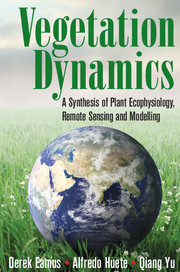Book contents
- Frontmatter
- Contents
- Preface
- Section One Plant Ecophysiology
- Section Two Remote Sensing
- 4 An Overview of Remote Sensing
- 5 Fundamentals and Physical Principles of Remote Sensing
- 6 Satellite Sensors and Platforms
- 7 Remote Sensing of Landscape Biophysical Properties
- Section Three Modelling
- Section Four Case Studies
- Index
- References
7 - Remote Sensing of Landscape Biophysical Properties
from Section Two - Remote Sensing
Published online by Cambridge University Press: 05 June 2016
- Frontmatter
- Contents
- Preface
- Section One Plant Ecophysiology
- Section Two Remote Sensing
- 4 An Overview of Remote Sensing
- 5 Fundamentals and Physical Principles of Remote Sensing
- 6 Satellite Sensors and Platforms
- 7 Remote Sensing of Landscape Biophysical Properties
- Section Three Modelling
- Section Four Case Studies
- Index
- References
Summary
Introduction
The goal of this chapter is to discuss the basic optical properties of common landscape surface features, including plants, soils, water and detrital material. Variations of these optical properties over space and time provide the basis for remote sensing advancements on the detection and characterization of physical, chemical and biologic landscape properties across global terrestrial ecosystems. The remotely-sensed signal is a combination of the intrinsic optical properties of landscape components interacting with spectral, angular (sun–view geometries) and polarization radiation aspects of the incoming solar radiation. Information collected in spectral, spatial, angular and temporal optical domains are utilized in the development of methods for retrievals of ecological, hydrological and biogeochemical variables.
Spectral Signatures
Remotely-sensed information about landscape constituents is most often obtained through analyses of spectral reflectance signatures acquired across the reflected solar spectrum (400–2500 nm). Landscape spectral signatures are a function of the optical properties of the biogeochemical constituents, moisture condition and the size, shape and geometry of leaf elements or litter and soil particles (Fig. 7.1). There is considerable knowledge about vegetation, soil, litter and water optical signatures obtained through extensive field and laboratory spectroscopic analyses (Ben-Dor et al. 2008, Ustin et al. 2004).
Vegetation Optics
The absorption spectrum of a green leaf is related to its chemical (pigments, lignins and cellulose), moisture and physical properties (Fig. 7.2). Leaf optical properties in the visible wavelengths (400–700 nm) are controlled by the presence of biologically active pigments which generally result in low reflectance due to strong absorptions by chlorophylls, carotenoids, xanthophylls and anthocyanins (Fig. 7.3; Chapter 2; Carter and Knapp 2001, Blackburn 2007). Strong chlorophyll absorption features in the blue (450 nm) and red (680 nm) result in a ‘green’ appearance to healthy leaves as there is less-absorption and more reflection in the green.
Leaf pigment contents provide valuable information on the physiological performance of leaves. Plant disease and stress will alter pigment contents and hence the visible spectrum (Knipling 1970). Mineral deficiencies affect chlorophyll content to varying extents with chlorosis directly affecting the visible spectra. Nitrogen deficiencies cause visible reflectance to increase and NIR reflectance to decrease by altering the number of cell layers and leaf necrosis results in spectral signatures comparable to that of senescent leaves (Gates et al. 1965).
- Type
- Chapter
- Information
- Vegetation DynamicsA Synthesis of Plant Ecophysiology, Remote Sensing and Modelling, pp. 206 - 236Publisher: Cambridge University PressPrint publication year: 2016



